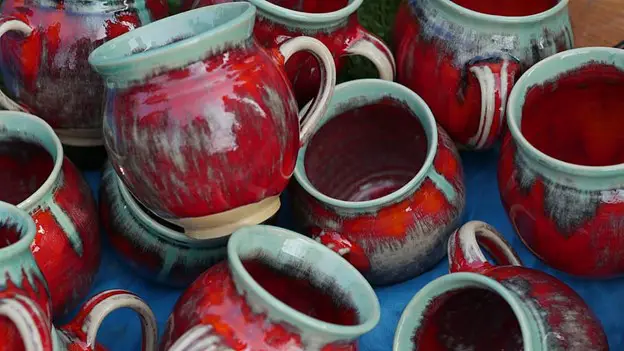Pottery artists that wish to experiment with visually striking patterns love to implement the use of crystalline pottery glazes. These glazes are popular for their shimmering, glass-like vibrancy. Moreover, when fired the right way, these glazes form intricate crystal-like structures during the kiln firing process. So, what really are these crystalline pottery glazes? And how do they work? Let us find out!
Crystalline Pottery Glaze: What Is It?
Crystalline pottery glazes are comprised of flux materials like potassium, lithium, or zinc alongside other colorants and minerals. When applied on the clay surface, it has to undergo a highly controlled firing process inside the kiln. Therefore, any significant rise in temperature or decrease in the same might not get you the desired result.
During the kiln firing process, the glaze tends to reach a temperature at which the flux materials present within the glaze tend to melt and move within the liquid. This forms a glass-like matrix. As the temperature drops post-firing, the glaze starts to solidify, forming crystals that grow within the molten glaze. However, the crystals’ growth is influenced by several factors, such as firing temperature, glaze composition, as well as cooling rate.
Keep in mind that the shape, size, or color of the crystals formed can differ and create unique and beautiful visual effects. For example, with some glazes, you can expect the formation of branching shapes, while with others, you might see needle-like or hexagonal formations. Furthermore, the crystals’ colors might also vary depending on the mineral content in the glaze.
Things To Keep In Mind When Firing Crystalline Glaze
- Crystalline glazes can be a bit runny in terms of consistency. So, it is important to use wax resist on the kiln shelves or fire it on a dish or pedestal to keep the kiln protected.
- It also has a high rate of failure due to its need for the right temperature and firing duration. Moreover, such glazes can also be very expensive, depending on the brand you prefer. So, the failure rate can be particularly frustrating.
- Crystalline glazes tend to have a particularly high rate of thermal expansion. So, it tends to craze a lot regardless of the clay body used. The key is to increase the silica content in the porcelain, which can massively reduce and even eliminate the effects of crazing.
- These glazes aren’t meant for dinnerware and aren’t food safe.
Here are some crystalline glaze brands you can try!
1. Sax Crystal Magic True Flow Glaze:
The Sax Crystal Magic True Flow Glaze features tiny crystals mixed into the formulation along with a speckled base for melting when fired. The firing process allows the colors in the glaze to bloom, providing you with unique and beautiful results. Moreover, the glaze is safe for use for beginners when fired at Cone 06. Although it is lead-free and non-toxic in nature, it isn’t recommended for use as dinnerware, given its surface characteristics. This glaze, when fired the right way, tends to provide a glossy finish. With the Sax Crystal Magic, you can also experiment with higher temperatures that go as high as Cone 6, giving you better and more solid crystal patterns. Make sure you mix the glaze properly using a stick to allow the crystals to spread out evenly as opposed to settling down at the bottom. Finally, you can apply as many as three thick coats on the pottery ware to get some vibrant results.

2. Mayco Crystallites Glaze:
If you love bright and vibrant colors, the Mayco Crystallites Glaze is the perfect option to experiment with. From northern lights to peacock eyes, these glazes impart a range of colors that bloom when fired perfectly in the kiln. The glaze can be fired from Cone 04 to 06, but it isn’t ideal for dinnerware. It works best with earthenware clay but can also be used with stoneware or porcelain. Make sure you use a tile test to confirm whether it fits your project.

Conclusion
Crystalline glazes are perfect for creating captivating ceramic artwork with intricate and visually appealing patterns. The glassy appearance makes it all the more unique. However, keep in mind that they can be a bit demanding. So, always read the label to find out the right firing temperature and duration to get the best output without wasting your expensive glaze.







